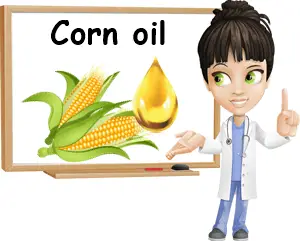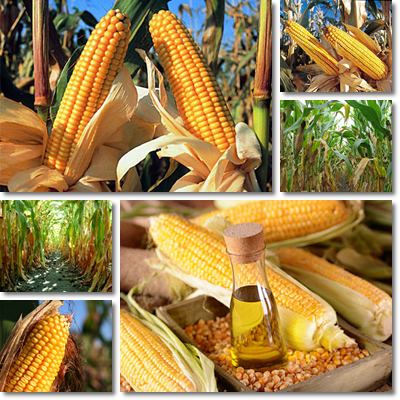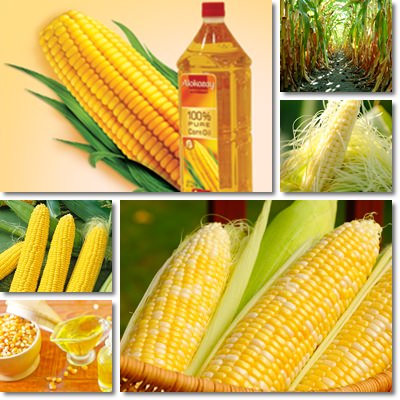Corn oil is a major component of Western diets. Its relatively healthy fat profile, low production costs and low price as well as higher smoke point make it an overall safe edible oil option. Corn oil is commonly used for skin and hair care but has other industrial applications. However, depending on how it’s produced and how we use it, it may be more or less beneficial for our health. Solvent extraction, improper use during cooking, excess consumption etc. can make corn oil less healthy for long-term use.
What is corn oil made of? Corn oil is made from the germ (embryo of the seed) of corn and is also known as maize oil. How is corn oil made? Firstly, corn seeds are pressed using a expeller pressing to mechanically remove the oily components from them. Afterwards, they are treated with solvents (chemicals derived from petroleum) to further extract any remaining oil. The solvents are then removed from the oil. Most of the time, the resulting oil is refined to remove certain fats with higher melting point, color and smell. This often implies heat treatment.

Unrefined vs refined corn oil. The process of obtaining corn oil could end with cold pressing and the resulting oil would be healthy, unaltered by chemicals or heat. However, cold pressing yields less oil whereas solvent treatment extracts the very last drops of oil from the kernels, making it more profitable for producers. The solvents are taken out from the oil towards the end of the production process and they are reused in other production processes, hence the preference for refined corn oil.
Experts agree refined cooking oils are not a health hazard when consumed in moderation, kept properly and not exposed to high cooking heat, but they aren’t healthy either. After all, the natural state of the oil in the corn kernels has been altered to significant lengths to offer it certain properties like a certain smoke point, color, odor, consistency or viscosity.
Organic, non-GMO vs GMO corn oil. Which is better of the two depends on our personal views on genetically modified organisms. While crossing different plants to get the best traits in one plant or improving the nutritional value of certain crops is okay, GMO foods may be a result of more dangerous practices such as irradiating seeds to make them more resistant to pests, herbicides etc. And despite claims that GMO foods are safe, we don’t yet know the real extent of their health effects as long-term studies have not been conducted in all seriousness on large populations.
In my opinion, cold pressed, organic, non-GMO corn oil is the best choice, despite the fact that it’s not as cheap as refined, GMO corn oil. Cheaper is usually not better because cheap often implies low quality. The foods that we eat get processed throughout our body and become part of us which is why it is so important to always go for healthy foods that are closest to their natural state and properties.

What does corn oil look like? Corn oil is yellow, with the mention that the refined varieties tend to be lighter in color due to refining processes. What does corn oil taste like? Corn oil has a light flavor, barely reminiscent of corn and usually imparts no particular taste to dishes. It’s practically flavorless. This might very well be a result of the refining process which strips the oil of its natural flavor and some of its color. It’s similar to sunflower seed oil: cold pressed sunflower oil has a noticeable flavor reminiscent of sunflower kernels, but refined sunflower oil is almost flavorless.
Fat content and profile
What is the fat content of corn oil? Corn oil is all fat (100% liquid fat).
What is the fat profile of corn oil? Corn oil contains the following fats:
1) Saturated fatty acids (12,948): about 13% of the total fat content. Corn oil contains little saturated fatty acids compared to other common edible oils such as coconut oil, palm oil or soybean and less even than olive oil. Saturated fatty acids are the types of fats found mostly in animal products such as butter or lard and are deemed dangerous for our health. However, research shows that they are the least likely to form dangerous byproducts when exposed to cooking heat and will not raise our LDL cholesterol levels unless we consumed then in great amounts regularly. In other words, having some butter on bread occasionally is healthier than frying potatoes in vegetable oil every other day. Still, it’s a good thing corn oil has little saturated fats.
2) Monounsaturated fatty acids (27,576). They make up about 28% of the total fatty acid content of corn oil. Monounsaturated fatty acids are healthy, but have been shown to form dangerous compounds when exposing to cooking heat, meaning (unrefined) corn oil is best consumed fresh.
3) Polyunsaturated fatty acids (54,677), or about 55% of the total fat content of corn oil. Polyunsaturated fatty acids are a healthy kind of fats, known to up HDL (good) cholesterol levels and help lower LDL (bad) cholesterol. Most of the polyunsaturated fats content of corn oil is represented by Omega-6 fatty acids, with very little Omega-3 in the form of alpha linoleic acid (ALA). Corn oil also contains beta-sitosterol, campesterol and stigmasterol, three compounds similar in composition to cholesterol, but with a beneficial action on cardiovascular health primarily.
Despite the fact that they are healthy, polyunsaturated fats may produce dangerous byproducts when exposed to cooking heat. Also, research has observed that modern diets have a high intake of Omega-6 and a very low intake of the healthier Omega-3 (an average ratio of 15:1, when the recommended ratio is 3:1 to 1:1). This means that corn oil is not such a great option because it’s pure fat and we should preserve a relatively low overall fat intake if we want to remain healthy.

Potential benefits
When it comes to how beneficial corn oil is for human health, it is good to remember that it is not a perfect food. Certain components in corn oil are good for us, others not so. And the ones that are good, are good only if we consume the oil in very small amounts and choose organic, unrefined corn oil. Overall, the main health benefits of this edible oil are a result of individual compounds, rather than an accumulation of all the properties of the oil. This being said, here is what (organic, unrefined) corn oil can do for us:
1) Beneficial action on LDL and HDL cholesterol. The relatively high content of healthy fats in corn oil can help raise HDL (good) cholesterol levels and lower LDL cholesterol. Phytosterols in the oil (campesterol, beta-sitosterol and stigmasterol) are responsible for such health effects. However, it is important to remember that too much of any type of fat, no matter how healthy, can have negative effects on cardiovascular health.
2) Antioxidant properties. The antioxidant action of corn oil is mostly a result of its vitamin E content (14,30 mg per 100 g) and has the most visible action of skin health. Vitamin E is known to protect the skin from the UV radiation from sunlight, limiting cell damage caused by free radicals. Moreover, vitamin E has been shown to help lower risks of Alzheimer’s disease and even prostate cancer.
However, we would have to eat too much corn oil to get a decent amount of vitamin E and the negative effects of a high intake of pure fat would outweigh the benefits of vitamin E. We can get our vitamin E elsewhere, preferably from nuts and seeds.
3) Immunity-boosting properties. Vitamin E and linoleic acid (Omega-6) contribute to the good functioning of multiple systems and are involved in supporting the immune function.
4) Excellent skin emollient. Organic, unrefined corn oil can be a great massage oil and topical treatment for dry skin and other skin conditions. Corn oil can be felicitously combined with essential oils to improve its fragrance and increase skin benefits. Corn oil can be an important dietary source of healthy fats and help our skin retain moisture, thus preventing dry, itchy, cracked skin. However, moderation is crucial.
5) Helps repair damaged hair. Corn oil can be applied directly on the scalp and along the length of the hair to repair damage, increase shine and improve hair texture and overall appearance. For best results, the oil should be used regularly (two to three times a week) and left to act at least 20 or 30 minutes before washing it off. It is a cheap, but efficient alternative to expensive professional hair treatments and can yield excellent results.
6) Potential benefits for high blood pressure. Research suggests that cold pressed, organic corn oil can have hypotensive effects, potentially improving cardiovascular health and preventing long-term complications and health risks of high blood pressure.
Considerations
How should we use corn oil and best enjoy its health benefits? Corn oil has a smoke point of around 232 degrees Celsius (or 450 degree Fahrenheit). This medium-high smoke point theoretically recommends the oil for frying and cooking at medium heat, but considering that cooking heat might lead to the formation of dangerous compounds, corn oil (as well as all vegetable oils) are safest at room temperature. Also, consumption should be limited, especially considering that corn oil has about 120 kilocalories per tablespoon. In addition tot his, there have been concerns that corn oil may promote cancer cell proliferation in estrogen sensitive cancers.
Overall, corn oil has its benefits, given certain conditions: as long as it’s unrefined and organic, consumed at room temperature, in moderation and not used for heat cooking. Of course, the nutrients that make corn oil healthier than other vegetable oils can be found in other healthier foods with less health risks, limitations and potential side effects, which is good to know, if anything.
